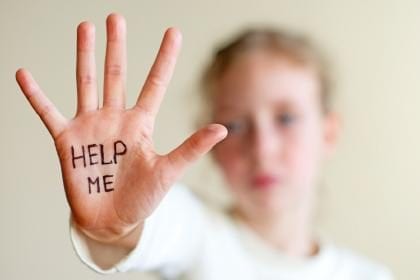
8 Common Signs of Child Abuse
Published: March 31, 2017
By: Stephanie Rodda
“Help me!”
How many of us would hesitate to respond to the desperate plea of a child in harm’s way? Surely not most of us. If we heard the call for help, if we were aware of the danger, if we were able, we would not refuse to aid a child in distress.
And yet, every day, children are abused, neglected and sadly to say, even die because their silent cries are not heard and therefore not heeded.
In the early 1980s, the beginnings of a National Child Abuse Prevention Month formed. Today, April is recognized as that month where focus and awareness is on how children can be better protected from the effects of abuse, maltreatment, and neglect.
In 1989, a grandmother tied a blue ribbon to her car antenna as she mourned the death of her three-year-old grandson who died as the result of abuse at the hands of his mother’s boyfriend. The Blue Ribbon Campaign has grown over the years to serve as a symbol of children’s lives lost due to abuse and neglect. http://blueribbonproject.org/
Awareness can help save the life of a child. Awareness can help prevent child abuse and neglect. Awareness can help us hear the cries for help when no words are being spoken.
What is child abuse?
At what point is action required? Exactly what should we do when we suspect a child is being harmed, at risk or being neglected? Who is required to contact the authorities and exactly what authorities should be contacted?
The Child Abuse and Prevention Treatment Act defines child abuse and neglect or child maltreatment as: “Any recent act or failure to act on the part of a parent or caretaker, which results in death, serious physical or emotional harm, sexual abuse or exploitation, or an act or failure to act which presents an imminent risk of serious harm.”
(http://www.apa.org/pi/families/resources/understanding-child-abuse.aspx).
8 common signs of child abuse
- Fear of going home
- Numb to emotions
- Lack of personal care or hygiene
- Inappropriate sexual behaviors/knowledge
- Wary of adult contact; may shrink at the approach of adults
- Lack of academic performance or ability to concentrate
- Long periods/constant crying
- Injuries-soft tissue injuries and hidden areas
How can I be certain that a child has been abused or neglected?
While reporting a possible child abuse situation should never be taken lightly, the child’s well-being must be the weightier of matters. According to the Alabama Department of Human Resources, “certainty is not required. In most instances, the only way you could be absolutely certain that a child had been abused or neglected would be if the parent or other person admitted it. All that is required is a reasonable suspicion that a child is a victim of abuse or neglect. After investigating the report, the department determines whether abuse and/or neglect occurred.” (http://www.dhr.alabama.gov/services/Child_Protective_Services/FAQs_CA.aspx).
There are mandatory reporters of child abuse and neglect such as teachers, doctors, etc. However, anyone can and should report the suspicion of a child being maltreated. In that case, you can contact your local sheriff’s office or police station and they will contact DHR, or you can contact DHR directly yourself:
Jefferson County Child Protective Services
Business Hours – 205-423-4500
After hours – 205-324-2135
Shelby County Child Protective Services
Business Hours – 205-669-3000
After Hours – 205-669-4181
As a foster parent for 15 years, I saw first-hand the long-term effects of child abuse. Some of the children I fostered are now grown with families of their own. Some have been able to forgive, but by in large family relations are so dysfunctional that even when they try to leave the hurt behind, the hurt hangs on to their hearts.
Recently I spoke with a former foster daughter and she and I discussed one of her greatest fears, which was turning out like her birth mom. Although we fostered and loved her and her adoptive family has loved her and helped her, she can’t stop trying to figure out how her birth mother could do the things she did. I told her she won’t be able to understand because it wasn’t understandable. But there are steps she can take to make sure she doesn’t fall into the same pit such as counseling and asking for help when feeling overwhelmed.
Prevention
Now that we know how to recognize it and how to report it, what steps can we take to prevent child abuse? Statistics show there are certain factors that make a family more at risk for child abuse like a history of abuse, violence or even poverty. A child who was abused as a child is more likely to abuse as a parent. But there are preventive measures.
We can help promote awareness by something as simple as a blue ribbon. We can attend events, we can donate to services for families at risk and we can refuse to look away when the signs of abuse are evident.
Stephanie Rodda is an adoptive mom of seven children and lives in the Birmingham area with her husband and children. She blogs, writes freelance articles, speaks to groups and at events and has authored two fictional novels which can be found at Amazon.com.
